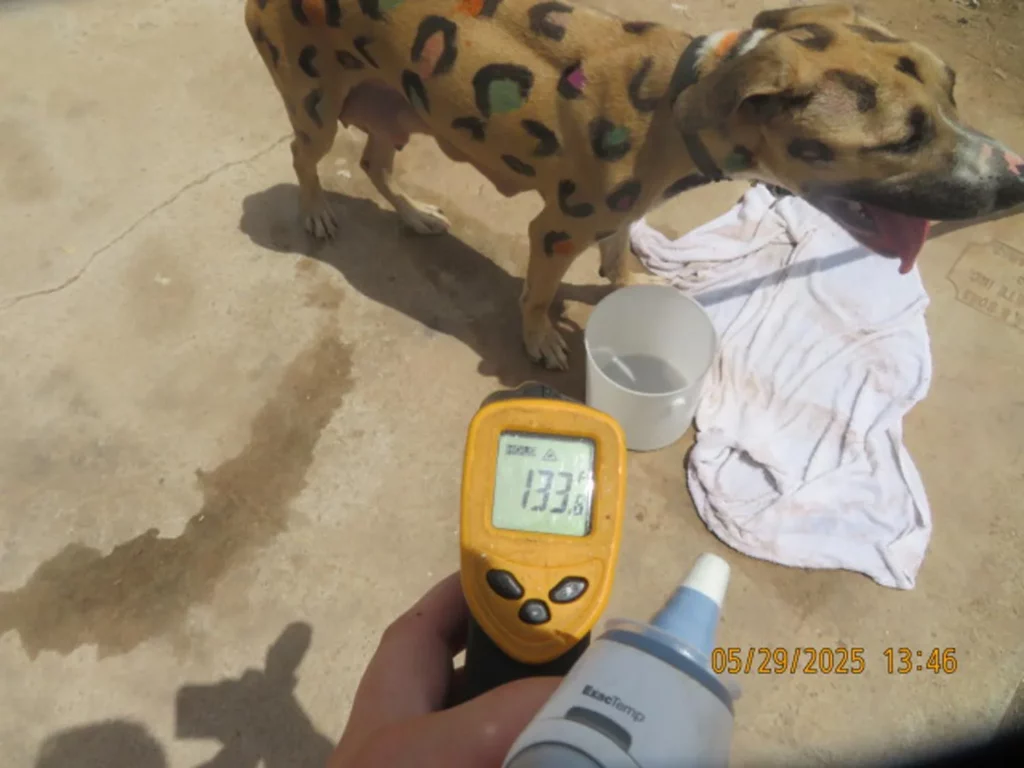On May 29, 2025, the Arizona Humane Society (AHS) in Phoenix received an urgent call: a neglected dog tied outdoors in 99°F heat. When emergency technicians, accompanied by Phoenix Police, arrived, what they found was beyond anyone’s expectations: a pit bull mother and her nine puppies—painted with leopard-like spots—tethered to a scorching concrete surface that reached 133°F
The mother, soon affectionately dubbed Rainbow Brite, faced critical health issues alongside her vulnerable “sprites.” What began as a routine call quickly transformed into a rescue story with a powerful message.
A Scorching Situation Saves a Leopard-Looking Mama

That late May afternoon in Phoenix, temperatures soared—and the concrete reflected the severity. Unable to wander into shade, Rainbow Brite and her pups were left exposed to intense heat. Vets recorded her dangerously high temperature—105.7°F—stabilizing her with cool towels before transporting her to Lazin Animal Foundation Trauma Hospital for emergency care
Her undernourished condition compounded the stress of nursing a litter in such harsh conditions. It was a stark reminder: neglect isn’t always hidden—it can literally boil over.
From Trauma to Tenderness in the “Mutternity Suites”
Once stabilized, Rainbow Brite and her nine pups transferred to AHS’s serene Maternity Suites—a haven designed for mothers in crisis. Here, they were safe, cool, and monitored round-the-clock. A TikTok shared by AHS—already amassing 75,000 views—humorously introduced the mother as a “leopard,” capturing her unique coat and her nurturing instinct
Watching her nurse and thrive under vigilant care marked a vital turning point—from imminent danger to slowly blossoming comfort.
AHS seized the moment to shed light on a critical issue: the perils of tethering dogs in extreme heat. Their message was twofold: such neglect is not only dangerous but, in many Arizona municipalities, illegal
Through social media amplification, the rescue story became a powerful educational tool, urging pet owners to reconsider outdoor tethering and providing reminders on hydration, shade, and safe housing—especially during summer.
Rainbow’s Rehabilitation & Future

Rainbow Brite and her pups are currently thriving under foster care. Post-medical evaluations—including spay/neuter surgeries and vaccinations—they’ll return to AHS for adoption
The mother’s leopard-like spots stem from a safe, likely non-toxic dye whose color will gradually fade. AHS reassured the public, stating, “We don’t know how or when she received her spots… but we are thankful she is cool, comfortable, and safe,” framing the phenomenon as harmless but eye-catching
A Ripple Effect for Animal Welfare
What began as one neglected dog tethered in Phoenix has evolved into a broader push for change. AHS hopes Rainbow Brite’s story will drive public awareness, foster policy changes, and strengthen community responsibility. “We are happy that her owner agreed to surrender her… a second chance at a new life,” AHS declared
Their messaging encourages proactive reporting and humane treatment—reminding us that even a single act of rescue can inspire a wave of compassion.
Beyond the Spots—A Lasting Message

Rainbow Brite’s journey—from a painted, heat-stricken pit bull to a social media darling—reveals more than a quirky rescue story. It surfaces critical truths about animal neglect, communal care, and the untapped power of storytelling. When a shelter’s plea for help turns into viral empathy, we glimpse how one rescue can transform into a catalyst for change. Will this serve as a wake-up call? If communities, shelters, and policymakers listen, perhaps it will. Until then, let’s remember sometimes, the most unlikely rescues carry the strongest messages.

Andrew Alpin from India is the Brand Manager of Doggo digest. Andrew is an experienced content specialist and social media manager with a passion for writing. His forte includes health and wellness, Travel, Animals, and Nature. A nature nomad, Andrew is obsessed with mountains and loves high-altitude trekking. He has been on several Himalayan treks in India including the Everest Base Camp in Nepal.






